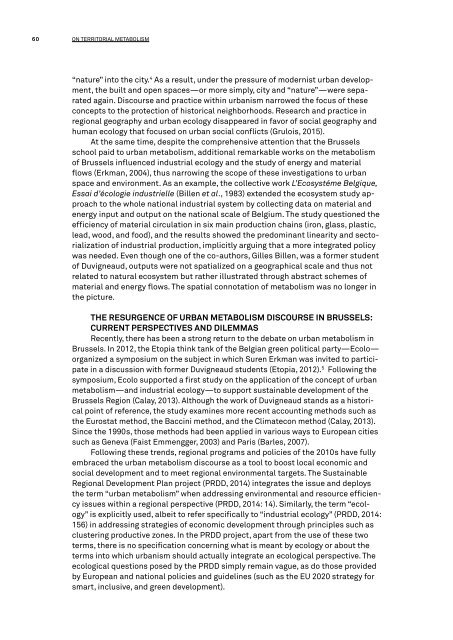DESIGNING TERRITORIAL METABOLISM
978-3-86859-489-8 https://www.jovis.de/de/buecher/product/designing_territorial_metabolism.html
978-3-86859-489-8
https://www.jovis.de/de/buecher/product/designing_territorial_metabolism.html
Create successful ePaper yourself
Turn your PDF publications into a flip-book with our unique Google optimized e-Paper software.
60 ON <strong>TERRITORIAL</strong> <strong>METABOLISM</strong><br />
“nature” into the city. 4 As a result, under the pressure of modernist urban development,<br />
the built and open spaces—or more simply, city and “nature”—were separated<br />
again. Discourse and practice within urbanism narrowed the focus of these<br />
concepts to the protection of historical neighborhoods. Research and practice in<br />
regional geography and urban ecology disappeared in favor of social geography and<br />
human ecology that focused on urban social conflicts (Grulois, 2015).<br />
At the same time, despite the comprehensive attention that the Brussels<br />
school paid to urban metabolism, additional remarkable works on the metabolism<br />
of Brussels influenced industrial ecology and the study of energy and material<br />
flows (Erkman, 2004), thus narrowing the scope of these investigations to urban<br />
space and environment. As an example, the collective work L’Ecosystéme Belgique,<br />
Essai d’écologie industrielle (Billen et al., 1983) extended the ecosystem study approach<br />
to the whole national industrial system by collecting data on material and<br />
energy input and output on the national scale of Belgium. The study questioned the<br />
efficiency of material circulation in six main production chains (iron, glass, plastic,<br />
lead, wood, and food), and the results showed the predominant linearity and sectorialization<br />
of industrial production, implicitly arguing that a more integrated policy<br />
was needed. Even though one of the co-authors, Gilles Billen, was a former student<br />
of Duvigneaud, outputs were not spatialized on a geographical scale and thus not<br />
related to natural ecosystem but rather illustrated through abstract schemes of<br />
material and energy flows. The spatial connotation of metabolism was no longer in<br />
the picture.<br />
THE RESURGENCE OF URBAN <strong>METABOLISM</strong> DISCOURSE IN BRUSSELS:<br />
CURRENT PERSPECTIVES AND DILEMMAS<br />
Recently, there has been a strong return to the debate on urban metabolism in<br />
Brussels. In 2012, the Etopia think tank of the Belgian green political party—Ecolo—<br />
organized a symposium on the subject in which Suren Erkman was invited to participate<br />
in a discussion with former Duvigneaud students (Etopia, 2012). 5 Following the<br />
symposium, Ecolo supported a first study on the application of the concept of urban<br />
metabolism—and industrial ecology—to support sustainable development of the<br />
Brussels Region (Calay, 2013). Although the work of Duvigneaud stands as a historical<br />
point of reference, the study examines more recent accounting methods such as<br />
the Eurostat method, the Baccini method, and the Climatecon method (Calay, 2013).<br />
Since the 1990s, those methods had been applied in various ways to European cities<br />
such as Geneva (Faist Emmengger, 2003) and Paris (Barles, 2007).<br />
Following these trends, regional programs and policies of the 2010s have fully<br />
embraced the urban metabolism discourse as a tool to boost local economic and<br />
social development and to meet regional environmental targets. The Sustainable<br />
Regional Development Plan project (PRDD, 2014) integrates the issue and deploys<br />
the term “urban metabolism” when addressing environmental and resource efficiency<br />
issues within a regional perspective (PRDD, 2014: 14). Similarly, the term “ecology”<br />
is explicitly used, albeit to refer specifically to “industrial ecology” (PRDD, 2014:<br />
156) in addressing strategies of economic development through principles such as<br />
clustering productive zones. In the PRDD project, apart from the use of these two<br />
terms, there is no specification concerning what is meant by ecology or about the<br />
terms into which urbanism should actually integrate an ecological perspective. The<br />
ecological questions posed by the PRDD simply remain vague, as do those provided<br />
by European and national policies and guidelines (such as the EU 2020 strategy for<br />
smart, inclusive, and green development).


















